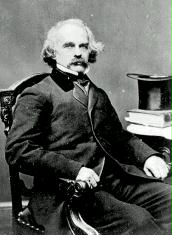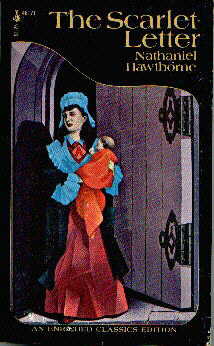Nathaniel Hawthorne
 Nathaniel Hawthorne, a fifth-generation American of English
descent, was born in Salem, Massachusetts, a wealthy seaport
north of Boston that specialized in East India trade. One of his
ancestors had been a judge in an earlier century, during trials
in Salem of women accused of being witches. Hawthorne used the
idea of a curse on the family of an evil judge in his novel
The
House of the Seven Gables.
Nathaniel Hawthorne, a fifth-generation American of English
descent, was born in Salem, Massachusetts, a wealthy seaport
north of Boston that specialized in East India trade. One of his
ancestors had been a judge in an earlier century, during trials
in Salem of women accused of being witches. Hawthorne used the
idea of a curse on the family of an evil judge in his novel
The
House of the Seven Gables.
Many of Hawthorne's stories are set in Puritan New England, and his greatest novel, The Scarlet Letter (1850), has become the classic portrayal of Puritan America. It tells of the passionate, forbidden love affair linking a sensitive, religious young man, the Reverend Arthur Dimmesdale, and the sensuous, beautiful townsperson, Hester Prynne. Set in Boston around 1650 during early Puritan colonization, the novel highlights the Calvinistic obsession with morality, sexual repression, guilt and confession, and spiritual salvation.
For its time, The Scarlet Letter was a daring and even
subversive
book. Hawthorne's gentle style, remote historical setting, and
ambiguity softened his grim themes and contented the general
public, but sophisticated writers such as Ralph Waldo Emerson and
Herman Melville recognized the book's "hellish" power.  It treated
issues that were usually suppressed in 19th-century America, such
as the impact of the new, liberating democratic experience on
individual behavior, especially on sexual and religious freedom.
It treated
issues that were usually suppressed in 19th-century America, such
as the impact of the new, liberating democratic experience on
individual behavior, especially on sexual and religious freedom.
The book is superbly organized and beautifully written. Appropriately, it uses allegory, a technique the early Puritan colonists themselves practiced.
Hawthorne's reputation rests on his other novels and tales as well. In The House of the Seven Gables (1851), he again returns to New England's history. The crumbling of the "house" refers to a family in Salem as well as to the actual structure. The theme concerns an inherited curse and its resolution through love. As one critic has noted, the idealistic protagonist Holgrave voices Hawthorne's own democratic distrust of old aristocratic families: "The truth is, that once in every half-century, at least, a family should be merged into the great, obscure mass of humanity, and forget about its ancestors."
Hawthorne's last two novels were less successful. Both use modern settings, which hamper the magic of romance. The Blithedale Romance (1852) is interesting for its portrait of the socialist, utopian Brook Farm community. In the book, Hawthorne criticizes egotistical, power-hungry social reformers whose deepest instincts are not genuinely democratic. The Marble Faun (1860), though set in Rome, dwells on the Puritan themes of sin, isolation, expiation, and salvation.
These themes, and his characteristic settings in Puritan colonial New England, are trademarks of many of Hawthorne's best-known shorter stories: "The Minister's Black Veil," "Young Goodman Brown," and "My Kinsman, Major Molineux." In the last of these, a načve young man from the country comes to the city -- a common route in urbanizing 19th-century America -- to seek help from his powerful relative, whom he has never met. Robin has great difficulty finding the major, and finally joins in a strange night riot in which a man who seems to be a disgraced criminal is comically and cruelly driven out of town. Robin laughs loudest of all until he realizes that this "criminal" is none other than the man he sought -- a representative of the British who has just been overthrown by a revolutionary American mob. The story confirms the bond of sin and suffering shared by all humanity. It also stresses the theme of the self-made man: Robin must learn, like every democratic American, to prosper from his own hard work, not from special favors from wealthy relatives.
"My Kinsman, Major Molineux" casts light on one of the most striking elements in Hawthorne's fiction: the lack of functioning families in his works. Although Cooper's Leather-Stocking Tales manage to introduce families into the least likely wilderness places, Hawthorne's stories and novels repeatedly show broken, cursed, or artificial families and the sufferings of the isolated individual.
The ideology of revolution, too, may have played a part in glorifying a sense of proud yet alienated freedom. The American Revolution, from a psychohistorical viewpoint, parallels an adolescent rebellion away from the parent-figure of England and the larger family of the British Empire. Americans won their independence and were then faced with the bewildering dilemma of discovering their identity apart from old authorities. This scenario was played out countless times on the frontier, to the extent that, in fiction, isolation often seems the basic American condition of life. Puritanism and its Protestant offshoots may have further weakened the family by preaching that the individual's first responsibility was to save his or her own soul.
